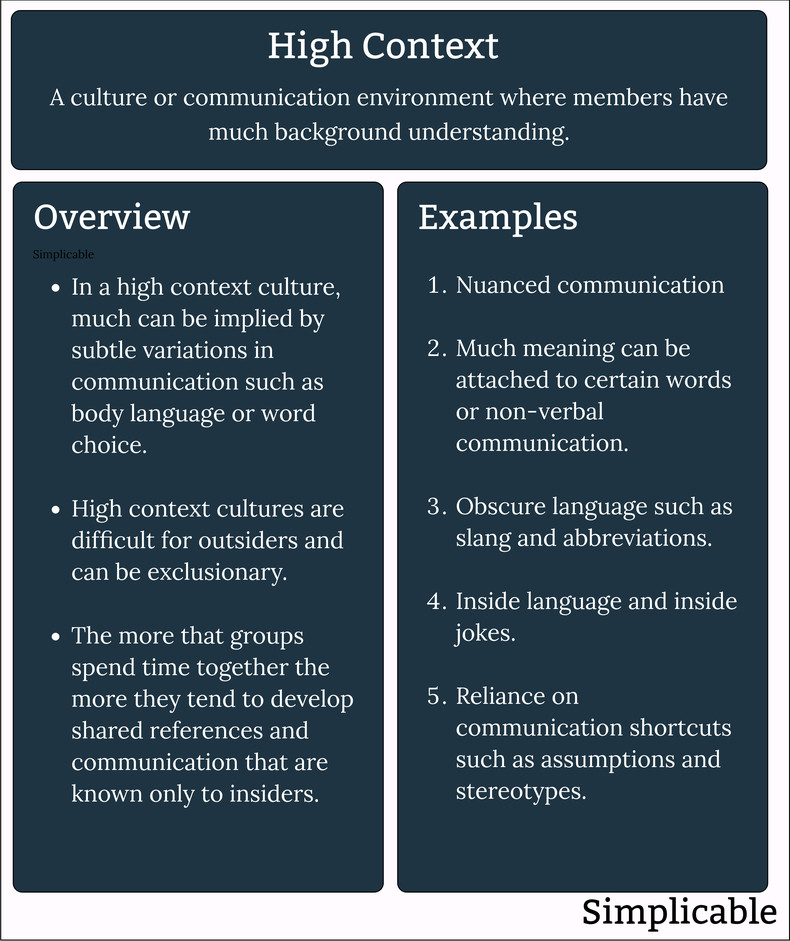
Nuance
Nuanced communication where much meaning can be transferred with slightly different ways of saying things. For example, the difference between a compliment and a sarcastic insult that all hangs on the pronunciation of a single word.Reading Between the Lines
In a high context environment, you are expected to read the subtleties of nuanced communication. For example, picking up on indirect criticism that is designed to help you save face.Careful Words
Much is read into what you say in a high context environment. As such, people may be careful with their words and stick to standard ways of saying things.Relationships
High context culture is common wherever there is a relationship between people. For example, families typically engage in high context communication whereby they can communicate much with subtleties such as a glace.Trust
High context cultures and situations may extend significant trust to members. For example, engineers who extend mutual trust and respect to other engineers.Emotion
High context cultures can be intensely emotional with an ability to express how you are feeling with great precision. This can be done in a subtle and elegant way with words that are emotionless if taken literally but deeply meaningful to those how have grasped the context.Implicit Information
Reliance on assumptions, stereotypes and other communication shortcuts. For example, assuming something about someone based on what university they attended.Closed / Exclusionary
High context cultures are difficult for outsiders as everyone is able to communicate at a level that requires much background information. They may also be actively exclusionary as groups that can enjoy the depth of contextual communication aren't always likely to explain things to someone who doesn't get it.Inside Language
Specialized language such as the jargon associated with an academic discipline or profession. Groups that spend time together commonly build unique language such as the inside jokes gathered by old friends.Collectivism
High context cultures tend to be collectivist whereby the duties of the individual to the group are valued over the freedom of the individual. Likewise, low context communication is required for individualism and freedom as this allows you to communicate freely with anyone.Stability
There is a loose association between high context culture and stability whereby high context cultures tend to value tradition and duty to institutions. In contrast, low context cultures may embrace change, risk taking and individualism.Conflict Avoidance
Group membership is valued in a high context culture whereby you have worked hard to be included in an environment that is inherently exclusionary. As such, members of the group avoid conflict with techniques such as polite language, saving face and social risk avoidance.Group Harmony
The experience of being able to communicate with precision and nuance with others in a low conflict environment is an enjoyable state that can be described as group harmony. High context cultures may seek to preserve group harmony such that disrupting group harmony may draw a strong response.Consensus
High context cultures may rely on consensus decision making as a means to reduce conflict. This is inherently inefficient and often produces poor quality decisions. The overall process of decision making may be logically aimed at preserving group harmony but the decisions output by this process may be logically indefensible.Social Structures
High context cultures can be based on social structures such as roles. For example, a language that has words and grammar that are considered feminine and masculine.Summary
High context refers to culture and communication environments that are based on significant background knowledge and shared experience such that much is communicated implicitly.
| Overview: High Context | ||
Type | ||
Definition | A communication environment that heavily relies on background information. | |
Related Concepts | ||






































